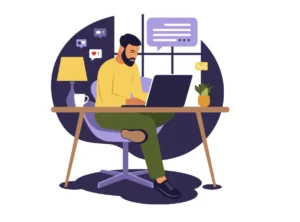Every successful product—from the paperclip to the iPhone—has a humble beginning as a mere germ of an idea, scribbled down on a napkin and engaged in more intense late-night conversations. Departure from “I have an idea” to “I have a product in the market” is like crossing a swimming pool. Miles apart as they are, however, they can still be traversed.
Think of these ten stations somewhat like the stations in a train journey. A raw thought is defined, extended, tested, challenged, and turned into something that is wanted and possibly paid for.
This article for generating product ideas unique for school projects, young professionals daydreaming of new product ideas that don’t exist, and anyone who secretly wishes to bring their late-night brainstorming to grand scale. Let us share the walkway.
Step 1: Capture and Define the Product Idea
It is preliminary to name the beast in any odyssey. A product idea is just a mental spark, but writing it down brings some clarity. Keep some document handy in which you can jot your thoughts down, whether an old-fashioned notebook, a Google Doc, or a bunch of sticky notes.

For students, these can be fun product ideas for school projects like “a water bottle that tracks hydration” or “a backpack with solar panels.” For professionals, it might be something more ambitious: “an AI-powered personal finance assistant.”
Pro Tip: Add one line about “why” for each idea. Why should this exist? This keeps your idea anchored to real-world needs.
Step 2: Ask—Who Needs This?
Brace yourself: the actual truth is that most product ideas fail due to no one actually needing them. Do not jump too far with an idea by designing a logo or envisioning a million-dollar funding. Ask this:
- Does it solve any real pain point?
- Who experiences this pain point?
Most students falter at this point because they quickly jump through the spectrum of “cool idea” to “final prototype” without stopping to confirm the fact that anybody outside their circle cares.
A smart pen, with lectures recorded, is indeed a captivating idea. But does it solve an already solved problem residing in smartphones? Test it.
Step 3: Research the Market Like Sherlock
Market research is not a business intelligence trick; it’s more of ‘Now where would you find a detective.’ Here is a list that could be helpful:
- Google Trends: Are people searching for answers to solve problems likened within your product idea?
- Forums: Reddit, Quora, or any other site holding information in some community groups will not let you down, in terms of human cries and efforts.
- Spy competitors: If the product you are building is in an already existing area, make sure to study and find out what the competition does and doesn’t do well.
Usually, this is when the white space is finally exposed in the context of new product ideas.
Step 4: Sketch Product Ideas Examples
Make your idea visual immediately. Sketch it or map out the flow; with some Lego models. But remember this discussion about art is not significant.

Horaay for sketches, especially in case students are going to display ideas at an upcoming science fair or innovation challenge! Bonus: This might be an idea about a student sketching “a lunchbox that keeps food warm without electricity.” Make it believable by putting it down in a simple flowchart.
For professionals, free tools such as Figma, Canva, or Lucidchart work well to populace digital ideas.
Step 5: Build a Simple Prototype
Prototyping doesn’t mean needing a factory. It serves to test the idea, so for a physical product, a low-cost, low-effort version, such as made from cardboard, or 3D printing, or assembling with household items.
For your digital products, get some experience working with no-code platforms, like Bubble or Glide, to knit together a basic demonstration of an app.

Its main purpose is to start getting something out that people will be able to see rather than only hear about, as unique product ideas which are ready to sell are only good in the ROI that end-users will perceive.
Step 6: Test With Real People
Feedback separates dreamers from builders. Don’t just show your product idea to your family (of course, they will tell you that it’s nice). Put it out to the strangers, classmates, or professionals.
Ask them:
- What do you like about it?
- What would you change?
- Would you actually use/buy this?
If you are a student with product ideas examples for a competition, your classmates are your target audience. If you are developing something larger, you should verify it with actual users who face the problem of your solution.
Step 7: Iterate Without Ego
From this stage forward, moral strength comes into the play. Several entirely new product ideas were thrown out time after time before one of them was finally accepted. Failure is the mother of success. Edison famously said, “I haven’t failed; I’ve found 10,000 ways that won’t work.”
Every test round is a learning experience. Maybe hydration-tracking water bottle is too expensive to make. Perhaps your smart pen becomes useless because mobile apps do the same thing. Listen. Learn. Rotate. Pivot.
Iteration does not mark the midway of failure, it is a climax of progressiro.
Step 8: Business Plan
Even smart ideas will eventually face the snuff in the absence of a business plan.
Think about:
- Pricing: Will they pay more to cover costs?
- Distribution: How are you planning to get this in their hands—online, retail?
- Revenue model: Will it be a one-time purchase, subscription, or freemium?
Young or old students can ask themselves this: “Will a friend of mine pay that much for that in our school project?” Professionals entertain thoughts of how they can scale.
Step 9: Build a Minimum Viable Product (MVP)
Minimum Viable Product means the leanest form of your idea that offers value. Think of it as “the heart of the idea.”
Dropbox did not really start with full cloud storage infrastructure. It started with a simple video demo showcasing the concept. That demo caught 5,000 signups even before the product was built.
This can be taken as an idea of the fact that, as one of those unique product ideas for sale or a niche app for communities, an MVP will forestall many years of futilely creating that which nobody might possibly consider themselves unable to possess.
Step 10: Launch, Learn, and Grow
Once the product is born into the world, launch marks not the end but the start. Boat your product idea around the world.
- Observe user experience.
- Watch metrics: downloads, purchases, engagement.
- Devote your energy solely to findings from the real-world data.
Basis for all real products: Whether it’s Instagram, Slack, or anything else, they always come from scratch. Then their founders listened, pivoted, and built what their users demanded.
Inspiring Product Ideas Product Examples
Examples of fun and practical product ideas are listed below:
- Some product ideas for students: Solar cell phone charger, self-watering plant pot.
- Some other unique product ideas for students: Wearable posture corrector, app to easily split group expenses.
- New product selling ideas: Biodegradable packaging that acts like fertilizer, voice-activated notebooks.
- Products for a school project: Energy-generating bicycle, eco-friendly air cooler.
Thus it is not about inventing the next iPhone overnight, being one of the bright ideas from new product ideas.
Why Students Should Peruse Product Ideas
Most students usually underestimate their creativity. Most unique product ideas usually originate from students. Some think about Facebook (conceived in a college dorm) or Google (derived from a research project).
Product ideas experiments for school projects teach the understanding of problem-solving, creativity, and entrepreneurship. Even if the business doesn’t succeed, you will have acquired valuable skills for whatever career path you journey in.
Why Professionals Should Chase New Product Ideas
Chasing new product ideas that are not there for working professionals becomes a creative outlet and a potential business door. That generally explains the birth of many startups when someone pronounces, “This could be easier.”
If you are stuck in your corporate routine, coming up with a great product ideas list would rekindle your curiosity. One or two of them may never get launched; but who knows, that one idea might change your entire path.
Choosing Unique Product Ideas to Sell
Choosing an idea should balance enthusiasm and practicality. Ask: Are people really in need of this? Can I actually build it with the available resources? Will I be motivated enough to carry it forward for a long time?
It’s brilliant, and without execution, that’s just a great idea. Rather, a simple and scrappy unique product idea to sell—executed steadily—can grow into something far larger.

Sparks to Stories
Ideas are terribly fragile. They start as whispers but can become revolutions. The key is not to romanticize the idea stage but to walk the 10 steps: capture, validate, research, sketch, prototype, test, iterate, plan, MVP, and launch.
Perhaps your product idea is imperfect. It may even fail. Yet experience will help to inform the next time; someday, you will hold something that existed only in your imagination.
Unlock Your Future with PW Skills PM with AI Course
The person getting interested in making such great product ideas into process product entities needs both the creativity and structural skills involved. The PW Skills Product Management Course with AI provides students with hands-on training in terms of management of products with integrated use of AI tools into practical business frameworks. Whether a student with experimental projects or a professional innovating, this course equips you to confidently go from idea to execution.
A product idea is the original thought or concept of something new you want to create-whether it be a gadget, app, or service. A truly good product idea solves a real problem for some people and is practical enough to be built and scaled latterly. Many of today's successful startups began as student projects. Students could easily experiment with pretty simple, inexpensive innovations that can be built on later. For example, AI-powered personal assistants, eco-friendly packaging, health-tracking wearables, and smart study tools for students.FAQs
What is product idea simplest?
How do I know if my product idea is good?
Can students make unique product ideas that actually sell?
Name new product ideas to sell in 2025.

